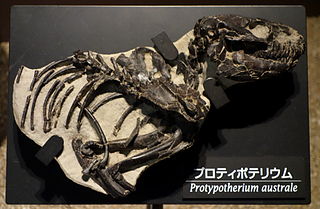
Protypotherium is an extinct genus of notoungulate mammals native to South America during the Oligocene and Miocene epochs. A number of closely related animals date back further, to the Eocene. Fossils of Protypotherium have been found in the Deseadan Fray Bentos Formation of Uruguay, Muyu Huasi and Nazareno Formations of Bolivia, Cura-Mallín and Río Frías Formations of Chile, and Santa Cruz, Salicas, Ituzaingó, Aisol, Cerro Azul, Cerro Bandera, Cerro Boleadoras, Chichinales, Sarmiento and Collón Curá Formations of Argentina.

Cramauchenia is an extinct genus of litoptern South American ungulate. Cramauchenia was named by Florentino Ameghino. The name has no literal translation. Instead, it is an anagram of the name of a related genus Macrauchenia. This genus was initially discovered in the Sarmiento Formation in the Chubut Province, in Argentina, and later it was found in the Chichinales Formation in the Río Negro Province and the Cerro Bandera Formation in Neuquén, also in Argentina, in sediments assigned to the SALMA Colhuehuapian, as well as the Agua de la Piedra Formation in Mendoza, in sediments dated to the Deseadan. In 1981 Soria made C. insolita a junior synonym of C. normalis. A specimen of C. normalis was described in 2010 from Cabeza Blanca in the Sarmiento Formation, in sediments assigned to the Deseadan SALMA.
Henricosborniidae is a family of extinct notoungulate mammals known from the Late Paleocene to Middle Eocene of Argentina, Bolivia and Brazil. The name honors U.S. paleontologist Henry Fairfield Osborn.

Interatherium is an extinct genus of interatheriid notoungulate from the Early to Middle Miocene (Colhuehuapian-Mayoan). Fossils have been found in the Santa Cruz, Collón Curá and Sarmiento Formations in Argentina.

Astrapotheriidae is an extinct family of herbivorous South American land mammals that lived from the Late Eocene to the Middle Miocene 37.71 to 15.98 million years ago. The most derived of the astrapotherians, they were also the largest and most specialized mammals in the Tertiary of South America. There are two sister taxa: Eoastrapostylopidae and Trigonostylopidae.
Proadinotherium is an extinct genus of toxodontid. It lived between the Late Oligocene and the Early Miocene in what is now South America.
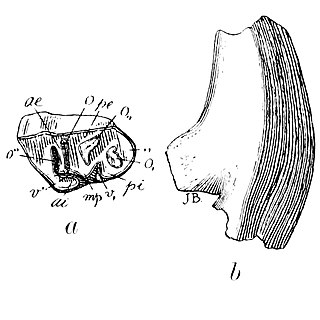
Argyrohippus is an extinct genus of notoungulate, belonging to the family Notohippidae. It lived from the Late Oligocene to the Early Miocene, and its fossilized remains were found in South America.
Propachyrucos is an extinct genus of hegetotheriid notoungulate. It lived from the Late Oligocene to the Early Miocene, in what is today South America.

Trachytherus is an extinct genus of mesotheriid notoungulate that lived from the Late Oligocene to the Early Miocene in what is now South America.

Eomorphippus is an extinct genus of notohippid notoungulate that lived from the Late Eocene to the Early Oligocene in what is today South America.
Colpodon is an extinct genus of herbivorous mammal, belonging to the order Notoungulata. It lived during the Early Miocene, in what is today Argentina and Chile, in South America.
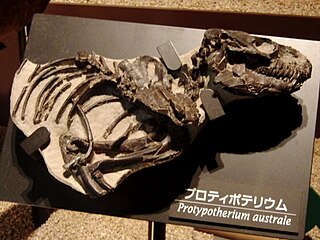
Interatheriinae is an extinct subfamily of interatheriids that consisted of notoungulates dating from the Early Eocene to the Early Pliocene. The subfamily includes the genera Archaeophylus, Argyrohyrax, Boleatherium, Brucemacfaddenia, Caenophilus, Choichephilum, Cochilius, Eopachyrucos, Federicoanaya, Interatherium, Juchuysillu, Miocochilius, Neoicochilus, Patriarchus, Proargyrohyrax, Progaleopithecus, Protypotherium, and Santiagorothia. They were small to medium sized interatheres, and when compared to the other subfamily, Notopithecinae, interatheriines are found to occupy an advanced, derived position in the family.
Juchuysillu is an extinct genus of interatheriid notoungulate. It lived from the Early to the Middle Miocene, and its fossils have been found in Bolivia.
Argyrohyrax is an extinct genus of interatheriid notoungulate that lived during the Late Oligocene, of what is now Argentina and Bolivia.
Patriarchus is an extinct genus of interatheriid notoungulates that lived during the Early Miocene in what is now Argentina. Fossils of this genus have been found in the Santa Cruz Formation of Argentina.
Santiagorothia is an extinct genus of interatheriid notoungulate. It lived during the Early Oligocene, and its fossils were discovered in Argentina and Chile.

Notopithecus is an extinct genus of Notoungulate, belonging to the suborder Typotheria. It lived from the Middle to the Late Eocene and its fossilized remains were discovered in South America.
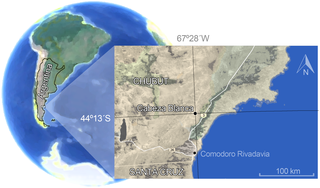
The Sarmiento Formation, in older literature described as the Casamayor Formation, is a geological formation in Chubut Province, Argentina, in central Patagonia, which spans around 30 million years from the mid-Eocene to the early Miocene. It predominantly consists of pyroclastic deposits, which were deposited in a semi-arid environment. It is divided up into a number of members. The diverse fauna of the Sarmiento Formation, including a variety of birds, crocodilians, turtles and snakes, also includes many mammals such as South American native ungulates as well as armadillos, and caviomorph rodents.
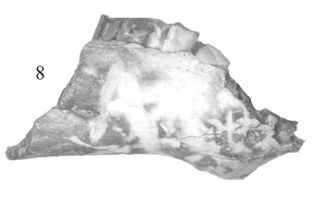
Eopachyrucos is an extinct genus of interatheriid notoungulates that lived from the Middle Eocene to the Late Oligocene of Argentina and Uruguay. Fossils of this genus have been found in the Sarmiento Formation of Argentina and the Fray Bentos Formation of Uruguay.
Progaleopithecus is an extinct genus of interatheriid notoungulate that lived during the Late Oligocene of Argentina. Fossils of this genus have been found in the Agua de la Piedra, Deseado, and Sarmiento Formations of Argentina.




















